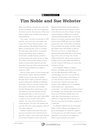Recycled landscapes
Add to My Folder
Create cityscapes and collages from rubbish and natural material that’s close to hand
A fascinating aspect of art is that the simplest of processes can produce the most striking work. An artist can take an idea that could happily feature in a creative activity in a Reception class – perhaps arranging a collection of natural materials, or assembling a sculpture from discarded junk – and use it to construct a work of art that is both complex and beautiful.
Tony Cragg’s sculptures made from brightly coloured found objects, such as Britain Seen from the North, are hugely popular with young visitors to Tate Britain, while Andy Goldsworthy’s assemblages of leaves, sticks, stones and found materials have inspired many successful classroom projects (see the A1 poster for an example of his latest work). Tim Noble and Sue Webster are two British artists who collaborate on striking sculptures that often take as their starting point huge quantities of waste – deliberately tempting the response that ‘modern art is rubbish’. Their work has inspired the sculpture activities on these pages. See Activity sheet 1, ‘Tim Noble and Sue Webster’ for more background information.
Getting started
- Before they embark on designing and building their sculptures, children will enjoy carrying out a collage activity. The basis of this activity will help the age-related activities opposite. It will provide children with opportunities not only to develop their observational drawing skills, but also to explore details of buildings – what makes one building distinct from another?
- Collect a range of images of buildings with interesting architectural features. Encourage children to provide examples of buildings that they have visited or seen, and to talk about the similarities and differences between the buildings. Draw children’s attention to the outlines of the buildings and ask them to make drawings in their sketchbooks of silhouettes of three or more examples. Challenge children to select examples that contrast with each other – the steeple of a church compared to the dome of a mosque, the minimalism of a skyscraper compared with the complexity of a cathedral.
- Children should then work in groups to select some of the more distinctive drawings and transfer them onto black paper, using grey pencil. Encourage children to work on a fairly large scale; they should then cut carefully around their silhouettes.
- Provide some large sheets of paper and a selection of ready-mixed paints so that the children can create a warm, striped sunset as a backdrop for the silhouettes. Children can then place their silhouetted buildings against the sunset: they should think carefully about the positioning of the buildings – overlapping them can be very effective.
- Finally, a few yellow lit windows can be added to the buildings before they are pasted into place. (See the ‘Silhouettes and sunsets’ activity opposite, for details of how to create city sculptures using computer software.)
Scholastic Resource Bank: Primary - join today!
- Over 6,000 primary activities, lesson ideas and resources
- Perfect for anyone working with children from 5 to 11 years old
- Unlimited access from just £1.25 per month
Already a member? Sign in below.
Published 26 September 2007
Reviews
Rated 4/5 from 1 rating
You need to be signed in to place a review.


